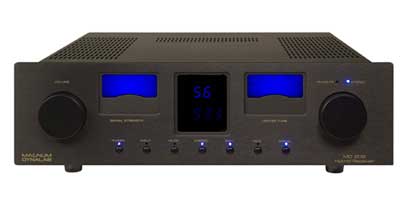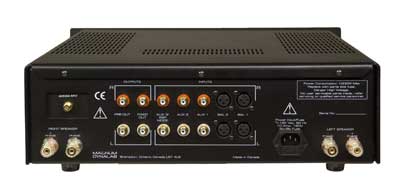| A window to the world of music |
Magnum Dynalab delivers CD-like quality with their
latest MD 209 FM Receiver
by Ernie Fisher
 When maturated audiophiles talk about FM radio, the MacIntosh
MR75 and MR80, the Marantz 10B and Sequerra are fondly remembered and it wasn’t until the eighties that Magnum Dynalab
joined the short list of distinguished FM tuners. Most contemporary
audiophiles weren’t born or were infants when most
of these distinguished tuners were making waves. Today’s
short list seems to have shrunk to a single tuner manufacturer,
namely Magnum Dynalab, the makers of the famous MD 108 and
MD 109 tuners. For at least ten years, MD has dominated the
high-end tuner market around the world, but along with this
accomplishment, they also produced the first audiophile satellite
tuner, some lower priced tuners, a fine receiver, the model
108, an integrated amplifier, the MD 309 and antennas that
actually work. MD’s latest component, however, is the
one under review here — a hybrid amplifier/tuner. When maturated audiophiles talk about FM radio, the MacIntosh
MR75 and MR80, the Marantz 10B and Sequerra are fondly remembered and it wasn’t until the eighties that Magnum Dynalab
joined the short list of distinguished FM tuners. Most contemporary
audiophiles weren’t born or were infants when most
of these distinguished tuners were making waves. Today’s
short list seems to have shrunk to a single tuner manufacturer,
namely Magnum Dynalab, the makers of the famous MD 108 and
MD 109 tuners. For at least ten years, MD has dominated the
high-end tuner market around the world, but along with this
accomplishment, they also produced the first audiophile satellite
tuner, some lower priced tuners, a fine receiver, the model
108, an integrated amplifier, the MD 309 and antennas that
actually work. MD’s latest component, however, is the
one under review here — a hybrid amplifier/tuner.
Appearance
The MD 209 is a large component, measuring 19 inches wide,
19.5 inches deep, 6.5 inches high and weighing in at
a whapping 51 pounds. My sample came finished with a black
faceplate (gold and silver are optional) fastened to
a sold black chassis. The faceplate sports two large windows,
which display signal strength and center tuning and a
somewhat smaller centered numeric volume indicator (the bluish
window tint reminds me of the classic MacIntosh look). A
row of small buttons provides access to the power, inputs,
mute, stereo, bandwidth 1&2 and signal.
The Sound
Listening to FM radio is likely an integral part of many
audio enthusiasts’ life — it is for me. When
the MD209 came in, I connected and operated it for a couple
of weeks, though I checked daily for sonic improvements as
it was burning in. In due time, I settled down to listen
to some serious jazz and classical music. Jazz FM in Toronto
is on 91.1, CBC FM is on 94.5, Classical FM is on 96.3 and
there are a number of stations I don’t bother with.
However, to check the MD 209’s capability to receive
station, I tuned in all I could receive and came up with
12 (listenable) stations and about four or five fringe
station from upstate NY and from almost 60 miles north.
This matched my previous experience with the MD 109 tuner
I had in-house for years.
What I cannot tolerate for long is when the station broadcast
is compressed, and this receiver will show it immediately
as its audio section is of superb quality. CBC broadcasts
are pristine and with a great tuner, it is frequently difficult
to distinguish the audio quality from that of a CD. My above-mentioned
favourite stations came across clear and rather musical,
making for delightfully involving musical entertainment.
In other words, the MD 209 has a superb tuning section.
The audio quality generated by the pre/power section of
the receiver is not good, it is superb. My first impression
was the receiver’s ability to create (or recreate)
a solid multi-dimensional soundstage that not only delineated
instruments and voices, but also revealed space and boundaries.
This made my auditioning loudspeakers vanish and set up a
listening space akin to a live event. This, however, was
not only with CD playback, but also when listening to iPod
and FM broadcasts. In fact, no matter what source component
used, the MD 209 performed beautifully. When I listened to
female and male vocals, the unit’s crystalline midrange
placed me front centre.
The transition into the high and low frequency ranges is
smooth and refined, characterizing the absolute tonal equilibrium
of the receiver’s amp section.
 Bass is surprisingly firm with good resolution down to about
30Hz and fair resolution to about 25Hz (my auditioning speakers
quit at 27Hz). Dynamics as well as micro dynamics are handled
with an organic finesse, not with unnecessary force or undue
frailty. This contributes to an effortless flow of the music,
where one can still enjoy a rousing crescendo and, simultaneously,
the gentle chime of a triangle. Bass is surprisingly firm with good resolution down to about
30Hz and fair resolution to about 25Hz (my auditioning speakers
quit at 27Hz). Dynamics as well as micro dynamics are handled
with an organic finesse, not with unnecessary force or undue
frailty. This contributes to an effortless flow of the music,
where one can still enjoy a rousing crescendo and, simultaneously,
the gentle chime of a triangle.
My Hammond B3 recordings with Jimmy Smith and Joey DeFanceso
showed the receiver’s potency to convey musical energy;
and my Shirley Horn CDs revealed its capacity to extract
inner detail.
I was (positively) shocked when I listened to the receiver’s
D/A converter. I had connected the Wadia 170I transport — a
digital iPod dock of superb quality. Though it offers analog
outputs as so many other docking stations, it also has a
digital output that extracts a digital signal from the iPod,
thereby keeping it in the digital domain without compression
when the recording was done loss-less. Having auditioned
it with another high-end system and an external DAC, I had
a good idea as to what to expect. Well, it seems that Magnum’s
built-in DAC is top notch as the variety of track I had ripped
on the Mac for my wife’s iPod sounded wonderfully
analog, totally harmonic rich and musically fulfilling.
Even downloaded, compressed tracks sounded better. Perhaps
this is the future of audio after all. If and when it happens,
the MD209 is ready for it.
The best way to characterize the MD 209’s sound quality
is to point out that it doesn’t add or subtract from
the music, but rather, provides an utterly organic sound — the
kind that makes it difficult to ignore
Synopsis
I had the earlier version MD receiver and reviewed it in
2002. I was quite happy with it giving it top rating. Nevertheless,
the MD 209’s performance offers much improved musical
essence — better harmonic capability, more appropriate
rendering of tonal hue and instrumental timbre and less “bite” compared
to its earlier solid state version.
The MD 209 receiver’s amp/preamp section belongs to
audio’s high-end category and will compete with many
distinguished separates I have run across over the years.
There isn’t a doubt in my mind that this “stereo
only” component is a breakthrough, even the paradigm
of modern audio receivers.
Peripheral auditioning components
- Pioneer Elite transport
- iPod
- Ethera Vitae
and Gershman M2 loudspeakers
- Argentum and BIS Audio
cables and interconnects.
|
| MODELS |
MANUFACTURER |
| MD 209 |
Magnum Dynalab |
| RATING |
CONTACT |
♪♪♪♪
|
Magnum Dynalab Ltd.
8 Strathearn Avenue, Unit 9
Brampton, Ontario
Canada
L6T 4L9
US Office:
2775 Broadway
Buffalo, NY 14227-1043
1-800-551-4130 (Toll Free)
www.magnumdynalab.com |
| PRICE |
$5,800.00 (US)
|
| |
|
|
 |
TECHNOLOGY
It would be simple to say that the receiver holds an amplifier
and a FM tuner. However, the component is rather exceptional,
as it is a hybrid design whereby the preamplifier section is
a superbly engineered tube gain stage that feeds its signal
to a solid state power amp. This drives the FM section, which
is based on the MD 108T tuner.
The preamplifier section employs customized tubes — the 6922 Reference
Cryovalve —, which relates to a cryogenic treatment rooted in the practice
or technique of deep-freezing (minus 350 degree F). Cryogenically treated tubes
avoid most internal stresses in materials used to assemble them, and require
a lengthy, expensive process, which includes slow cooling. This stabilizes
the tube components and significantly lowers the noise floor. To enhance its
socket contacts, the MD 6922’s through-glass pins are cleaned back to
base metal and polished — a procedure that results in greatly improved
connections, thus improved sound. The final step is to burn in the treated
tube, which takes another 100 hours, or so. However, the final product is of
extremely high quality and ideally suited for high performance, high-end audio
application.
The receiver produces 120 watts into 8 ohms, 250 watts into 4 ohms. Its frequency
response is from 2Hz to 100kHz (+/- 0.1dB). It operates in class A up to 50%
of gain, then switches to class A/B. Harmonic distortion is quoted at 0.05%;
signal to noise ratio is 115dB; input sensitivity is 1.2 volts (full power)
input impedance is 10k ohms, output impedance is 2Kohms. The receiver is equipped
with two balanced and three single-ended inputs (surround sound can be accommodated),
while it sports one preamp output, three digital outputs (two coaxial, one
USB).
The most important tuner specs are:
Usable sensitivity (mono) 0.7 u V 9.0 dBf50; dB quieting (mono) 2.0 u V 9.9
dBf50, (stereo) 2.3 u V 20.0; capture ratio is 1.5 dB; image rejection 125.0
dB; alternate channel (narrow) >80.0 dB; adjacent channel (wide) 3.0 dB;
adjacent channel (narrow) 30.0 dB; THD (mono) 0.10%, THD (stereo) 0.10%; stereo
separation 50.0 dB; AM suppression 70.0 dB; SCA rejection 80.0 dB; IF rejection
80.0 dB @19 KHz & 38 KHz; component rejection 75.0 dB.
Magnum’s Director of Audio Design Zdenko Zivkovic has
developed the hybrid-acoustic design platform, with a unique
circuit path that provides long tube life (anticipated to be
greater than seven years under normal use) and high-current
output.
The design generates half of its gain from the triode stage
and adds the additional gain with solid state devices. Its
output stage produces power with 20 Sanken output transistors
(10 per channel), that amplify current, rather than voltage.
This method is said to alleviate critical stress off the 6922
Cryovalve tubes, thereby eliminating the need for traditional
output tubes commonly employed by tube amps. The technology
promotes long tube-life when combined with high-current output
devices.
The MD-209’s power supply employs a shielded 650V torroidal
transformer and eight electrolytic capacitors and delivers
current to all critical components. 80,000uF of filtration
ensure a flat DC supply of power. Wiring is done with Kimber
Hyper-Pure cables.
The MD-209 is equipped with an advanced Digital-to-Analog
converter, featuring a full-time upconverting and oversampling
Burr-Brown design. Three digital inputs (including USB), allows
integration with virtually any digital source components (try
your iPod with loss-less rips).
WBT binding posts and Cardas RCA connectors are the unit’s
finishing touches. |
|
